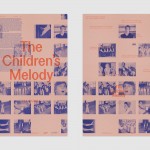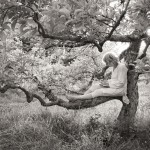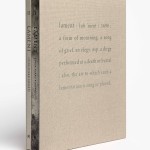Michael Rababy: CASINOLAND: Tired of Winning
Photographs are thought made visible. So in Casinoland we encounter not only the subject—casinos—we encounter Michael Rababy and his thoughts on this most complex subject. Is there a theme to Michael’s thoughts and work? Yes, it is to tell the truth. That is what motivated him and that is what resonates in this deep and penetrating book. “CASINOLAND – tired of winning” is landmark documentary photography on a subject of great significance to understanding America in our time.⁃ Sam Abell – photographer and educator (National Geographic)
I don’t remember the first time I visited Las Vegas. Perhaps on a family road trip, where we certainly would have found a small motel on the outskirts of the city. Later as an adult, I convinced my husband that visiting this city of extremes would be hilarious and an adventure. Quickly, the high hopes of frivolity and merriment descended into a slow depression on the state of humanity.
Michael Rababy has documented this city of high hopes in a new book, CASINOLAND: Tired of Winning, published by Kehrer Verlag. His monograph is a thirty year long photography project in which he documents US American gambling culture. Rows of shrill slot machines, glowing billboards, and gaudy splendor appear alongside exhausted faces, tired looks, and lost games. Rababy’s realistic camera view scrutinizes the glamorous appearance of the gleaming gambling halls and exposes their mendacious promises of wealth. The series focuses more on the casino as a capitalist institution as a whole than on the individual gamblers.
Rababy will be doing a book signing event at Camino Books in San Diego (del Mar) tomorrow.
Collectible copies signed with artist stamp available here (with free archival print – limited time offer)
Kehrer Verlag (international orders):
https://www.kehrerverlag.com/en/michael-rababy-casinoland-tired-of-winning-978-3-96900-164-6
“I took it as divine intervention that the slot machines wouldn’t accept my $100 bill, and left off gambling. there was a mournful, subdued air about the casino floor on a weeknight with the desultory few patrons resigned to their certain fate. it seemed like we were all being punished. I stopped for a ‘drink’ at the bar. I ordered chilled vodka neat, nothing else. what I got was water with lemon and perhaps a hint of vodka. ‘what’s with the drink?’, I asked the bar tender. he made an ‘I’m sorry’ face. ‘you get what you pay for?’, he offered. drinks are free.” —Yelp review
Just because life is meaningless doesn’t mean it can’t be enjoyable. – scotty hendricks on albert camus – the myth of sisyphus
CASINOLAND – tired of winning
I hated going to Las Vegas as a child. My mom would get mad at my dad for gambling too much and he would get mad at her for pulling him away from what he would later claim was the winning spot. We’d always be miserable driving home. Honestly, I don’t know why we went as a family.
I enjoy going to vegas as an adult — not for the gambling (I don’t gamble). I go for the people watching. Everywhere I see the saturated colors and flashing lights, the luring signs assuring non-stop fun, the percussive sounds of chaos demanding attention, the poetry of losing, the art of walking away and the great irony that many don’t seem to be having the joy they were promised.
Living in Southern California, we are exposed to casino commercials promising beautiful people, fine food, easy money, bottomless fun and you may even meet the sexy soulmate of your dreams. That’s not what I see. This is my visual translation documenting these unfulfilled promises for over 30 years.
My father and my mother’s mother both ended up with Alzheimer’s. Maybe somewhere inside, my DNA is aware of the fleeting human memory and I need to visually capture the world I see, as I see it. There is a connection here with my first book “american bachelor” — I’m documenting people living their lives, trying to have a good time and hoping that something spectacular is just around the corner.

©Michael Rababy, casino, asbury park 2010 (from CASINOLAND – tired of winning) Asbury Park, New Jersey is also home of the Stone Pony, where Bruce Springsteen got his start. The casino that stands today was constructed in 1929 to replace the original wooden frame casino that was destroyed by fire in January of 1928. The original casino building was erected in the Winter of 1903-1904. published by Kehrer Verlag
Tell us about your growing up and what brought you to photography!
It seems like a majority of artist bios of photographers open with them getting a brownie camera when they were young or having access to their father‘s dark room… I didn’t have any of that, but I was always drawn to photography probably starting around sixth grade when friends started to get cameras. In college I was lucky enough to study abroad in Florence, Italy for a semester and had a great teacher James White, who I recently reconnected with in Los Angeles. I knew I wanted to capture my experience in Europe, so I bought my first SLR just before the trip and I’m really glad that I did. It was a wonderful time and a magical place where you could take a photo of a trashcan in a back alley and it was a work of art.
After college, I came to Los Angeles to make films and while I was waiting for my big indie feature to get off the ground, I could just grab my camera and walk the streets and make work without any notes and without a budget. Now I have 2 closets full of negatives and prints.

“no right turn, downtown las vegas, early 1990s” (from CASINOLAND – tired of winning) ©Michael Rababy, This is one of the earliest images in the book featuring what was remaining of the original Fremont Street in downtown Las Vegas. The “NO RIGHT TURN” sign could be interpreted as an auspicious warning. 35mm film. (from CASINOLAND – tired of winning)
What prompted you to dig into your archives and bring this work to light?
In 2019, I started going through and scanning all of my negatives, small cheap ones – just enough to have my entire archive in Lightroom – but the idea for CASINOLAND came before that. I was planning to make the book before Covid, but then the california love – a visual mixtape book started to take shape so I put the casino book on hold until the California book was complete. But it’s notable that the work of scanning the old negatives paid off as I was able to find more 35 mm images to incorporate into the project which goes back to the early 90s.

©Michael Rababy, “the burger king with yellow flower, las vegas, 2007” I met this guy after a night of street photography. I’m guessing he was up all night as well. To quote Hunter S.Thompson, “buy the ticket, take the ride”. He appreciated having his portrait made and let me position him. The yellow flower takes this image to the next level. (from CASINOLAND – tired of winning), published by Kehrer Verlag
How did the book come about?
Since I’m always shooting street photography, I find that I gravitate toward certain subjects over time and the work takes a shape and becomes a documentary project. At some point I realized I had been drawn to the casino aesthetic (not just Las Vegas, but I had a chance to visit Atlantic City, Reno, Tahoe, and other places) and as I found my camera being drawn to these locations. I started to dig deeper as to why.
Growing up in Southern California, you see all these ads for local casino and commercials for Vegas as well. They’re pretty absurd and the reality that I see when I’m there rarely matches the promise of their commercials, so ultimately this project is my visual translation of what I see when I’m there versus the lifestyle they sell.

©Michael Rababy, casino couple poolside, 2009” (from CASINOLAND – tired of winning) A couple lounges poolside under a vintage “CASINO’ sign. Las Vegas, Nevada – 2009, published by Kehrer Verlag
What drew you to Las Vegas and the casino lifestyle? I always find an innate sadness when I visit Las Vegas, what is your reaction to the place?
Yeah, it can be tough. I was there one time walking on the strip and suddenly was struck by the desperation and had to go back to my room and chill out. It’s definitely not for everybody, but I don’t think that my work is focusing on ugliness necessarily. I think one can draw that conclusion, but for some people, this is their reality, and for some people it would be a fantasy to go visit anywhere because not everybody has the means to travel or leave their home environment.
I’m interested in documenting people and always try to capture real authentic emotion. My first book, american bachelor is described as an unguarded view of the time in a man’s life between college/school and marriage. Some bachelors tried to impress me as I documented them, but I feel like I was able to capture honest, true life experiences.
Similarly, places like Las Vegas and Reno feel very raw to me. It’s tricky as a documentary photographer – you don’t want to shoot down on your subjects, but that can be a very fine line. Ultimately, this is judged subjectively by the viewer and will depend a lot on where they’re coming from. The viewer brings so much when looking at art. Any art.
Las Vegas is pretty visually stunning. The lights, the people who work there and the people visiting, the architecture, the mass consumerism on steroids… It’s a heightened reality that is captured often, but I tried to do it in my own unique way.

©Michael Rababy, elvis at slots, las vegas, 2012 (from CASINOLAND – tired of winning) An Elvis impersonator sits at a slot machine in Las Vegas. The rhinestone costume bedazzles both the character and the environment. published by Kehrer Verlag
Is there anything that you learned or perceived in revisiting this work?
I spent a long time putting this book together, made even longer by the break while doing the California book. I did a lot of research and learned so much about how casinos are designed to keep people gambling from the carpet patterns to the sounds to the architecture to the way that the seats are designed, it’s really fascinating and there’s a great book Addiction by Design: Machine Gambling in Las Vegas by Natasha Dow Schüll if anyone is interested in learning more.
I’ve never been one to gamble. I’m not even a gamer, and even as a young child, I had a sense that the money that built all these casinos and hotels came from losses that people left in Las Vegas from their gambling. Making this book definitely galvanized my feelings.
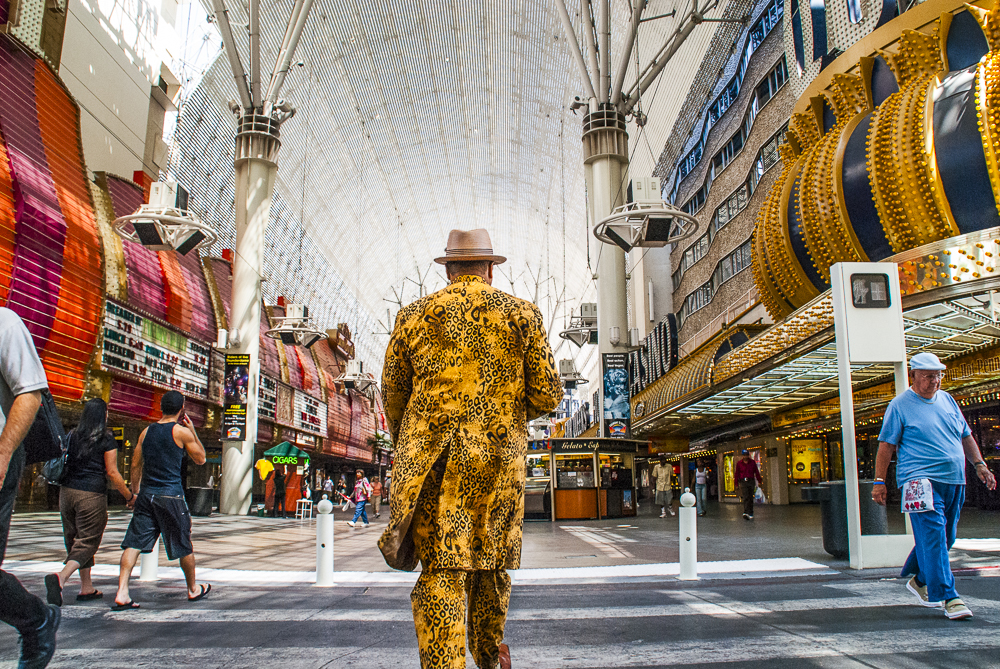
©Michael Rababy, man in gold – fremont street, 2007 The gold and black of this man’s outfit is visually synchronized with the casino he is walking toward. The covered sky allows for a nice silhouette. (from CASINOLAND – tired of winning) published by Kehrer Verlag
What is inspiring you lately?
Well, I came to LA to make movies, and now that the industry is imploding, I actually think it’s a really good time to do a really creative super low budget indie film, but I also have been making images for so long that I have three other monographs that I would like to make as well as a book on Los Angeles that I hope to curate and create through LACP in 2027 leading up to the 2028 LA Olympics, so as usual my plate is over full.
But I’m lucky, as a curator (I’m the photo curator for the Hive Gallery downtown LA) I’m always looking at and presenting new work that excites me. I get to exhibit work by veteran artists who I love getting the chance to meet, as well as beginner photographers who’ve never exhibited before. I am also starting the LA photobook club with other members from LACP with the goal of attending book and photo festivals and making books in the future, like the Los Angeles book I mentioned. So stay tuned.

©Michael Rababy, showgirl with pink feathers on escalator, 2022 Sunlight illuminates the pink and purple feathered showgirl rising up an outdoor escalator on the Las Vegas Strip. (from CASINOLAND – tired of winning), published by Kehrer Verlag

©Michael Rababy, “fremont street spectacle, 2012” (from CASINOLAND – tired of winning) There’s a lot going on in this image. published by Kehrer Verlag
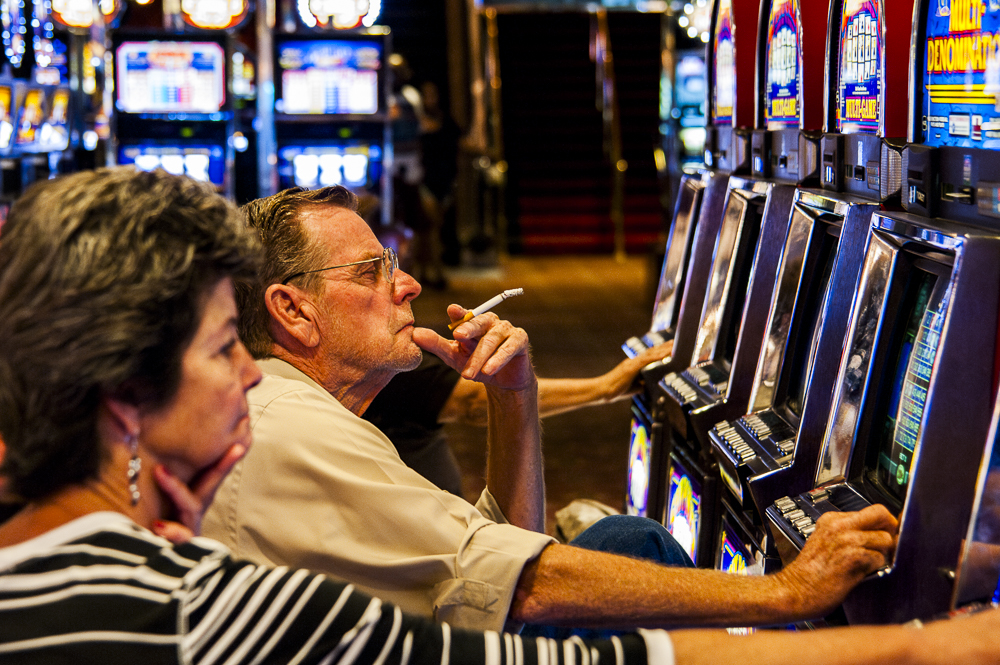
©Michael Rababy, man with cigarette at slot machine, 2012 (from CASINOLAND – tired of winning) A man contemplates at a slot machine with a very lit cigarette. published by Kehrer Verlag

©Michael Rababy, bride at soda machine, 2009 A young bride in Las Vegas chooses her drink of choice at a soda fountain. An average of 7,000 marriages occur in Clark County, Nevada every month. from CASINOLAND: Tired of Winning , published by Kehrer Verlag

©Michael Rababy, casino maid, las vegas, 2009 A casino hotel housekeeper appears to covey a contemplative expression. from CASINOLAND: Tired of Winning , published by Kehrer Verlag

©Michael Rababy, man with 4 children outside casino, 2016 A man seemingly waits outside a casino while watching four young children. published by Kehrer Verlag

©Michael Rababy, eldorado, reno, 2017 The Eldorado in Reno, Nevada opened in 1973.(from CASINOLAND – tired of winning) published by Kehrer Verlag

©Michael Rababy, bus reflection at dawn, las vegas, 2008 I had been photographing all night and captured this on a bus returning to my hotel. Against the reflection of the bus window, we see people going to and coming from work with the Las Vegas Boulevard street sign in view. from CASINOLAND: Tired of Winning , published by Kehrer Verlag
Lebanese-American documentary / street photographer, filmmaker Michael Rababy likes to create pictures of people. He studied art history at the University of San Diego before spending time in Paris. taking influence from Henri Toulouse-Lautrec and Henri Cartier-Bresson.
His ethnographic documentary book “american bachelor” details the highs and lows of the single male, followed by “folsom street food court”, an irreverent take on the annual street fair in san francisco. His clients / credits include Billboard Creative, E!, Google, Hamburger Eyes, LA Weekly, Mercedes-Benz, People Magazine, the Sundance Institute, Time-Out New York, VICE magazine, the Village Voice and the Yes Men. his street photography was featured on the oxygen network’s Girlfriend Confidential:LA and he was the official portrait photographer for TLC’s highly rated series LA Ink. Michael is also the photography curator of the Hive Gallery in the downtown Los Angeles arts district since 2015 and created the book “california love – a visual mixtape” (2020). His latest book “CASINOLAND – tired of winning” is his fourth book.
His short film ‘still lives’, which tells a story through black and white still photographs set to piano music, premiered at the Palm Springs international short film festival, was an official selection of the Miami short film festival. his film ‘january man’ screened as an official selection at at the Boston international film festival and the Miami short film festival. Overall, his work can be described as emotionally charged poetic-realism.
Michael lives in California and is currently at work on his latest masterpiece.
Instagram: @Fullonrad
Posts on Lenscratch may not be reproduced without the permission of the Lenscratch staff and the photographer.
Recommended
-
Andrew Waits : The Middle DistanceDecember 20th, 2025
-
Photography Educator: Juan OrrantiaDecember 19th, 2025
-
Aaron Rothman: The SierraDecember 18th, 2025
-
Eli Durst: The Children’s MelodyDecember 15th, 2025
-
Paccarik Orue: El MuquiDecember 9th, 2025



























